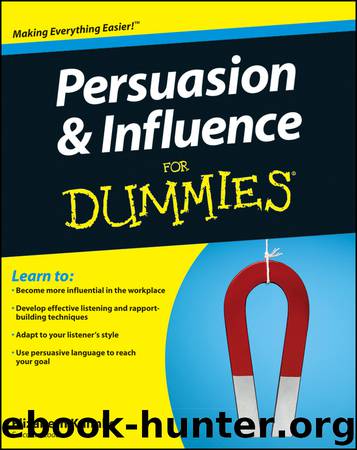Persuasion and Influence For Dummies by Elizabeth Kuhnke

Author:Elizabeth Kuhnke
Language: eng
Format: epub
Publisher: Wiley
Published: 2011-09-26T04:00:00+00:00
Chapter 9
Gearing Your Approach to Different Decision-Making Styles
In This Chapter
Determining someone’s decision-making style
Adapting your arguments to match your listener
Focusing on your delivery
Working out your words
Working with a mixed group of decision-making styles
Simply put: people are different, particularly in the ways in which they make decisions.
Some people have strong aversions to risk, while others can’t get enough. You meet individuals who are suspicious of any data that doesn’t match their pictures of the world, whereas others just rely on their instincts. Some base their decisions on what worked in the past, whereas others focus on facts and analysis, afraid to make independent decisions.
If you apply a one-size-fits-all approach as you attempt to influence others, you’re in for a rough ride and, most likely, failure. Instead, you can craft an approach tailored to how the person you want to persuade makes his decisions.
In this chapter I describe the subtle differences between five familiar decision-making styles. I show you how to identify and persuade each type, including specific buzzwords you can use to appeal to each style, as well as the best types of information and presentation formats that win over your listeners.
Knowing Who’s Who and What’s What
Knowing how to interpret and respond to the words, actions and attitudes of people who make decisions that impact on your life leads to secure and effective relationships. Whether you’re influencing your boss, a colleague or members of your family, knowing how to convert your suggestions into compelling cases can turn your proposals into winning propositions.
For their 2004 book, The 5 Paths to Persuasion, which explores how leaders make decisions, executive consultants Gary Williams and Robert Miller interviewed nearly 1,700 executives across a wide range of industries. They identified five predictable types of decision-making processes: charismatics, sceptics, thinkers, followers or controllers. Persuasion works best when adapted to fit one of the five. Their findings show that to be a successful persuader you need to:
Customise your proposals. Organise your information in the way that appeals to your listener. You must direct your arguments to your decision-makers’ preferred styles, otherwise you don’t stand a chance of persuading them to accept your proposals.
Become adept at interpreting behaviour. People only make major decisions after collecting and processing information in their preferred style. As a persuader, you must carefully observe the person you want to persuade in order to know which style you’re dealing with.
Assemble a full toolkit to draw from. In order to influence the different types of decision-makers, you need to know what tools to use, as well as when and in what order.
Williams and Miller stress that their research is based on how people make decisions and is not influenced by personality types. Furthermore, while most people’s decision-making styles change according to circumstances, when making difficult choices involving complicated issues and significant consequences, people revert to type. In other words, when the pressure’s on, you use what worked in the past.
Williams and Miller also note that while some
Download
This site does not store any files on its server. We only index and link to content provided by other sites. Please contact the content providers to delete copyright contents if any and email us, we'll remove relevant links or contents immediately.
Nudge - Improving Decisions about Health, Wealth, and Happiness by Thaler Sunstein(7261)
Deep Work by Cal Newport(6587)
Principles: Life and Work by Ray Dalio(5984)
The Doodle Revolution by Sunni Brown(4517)
Factfulness: Ten Reasons We're Wrong About the World – and Why Things Are Better Than You Think by Hans Rosling(4498)
Eat That Frog! by Brian Tracy(4166)
Thinking in Bets by Annie Duke(4008)
Hyperfocus by Chris Bailey(3919)
Visual Intelligence by Amy E. Herman(3632)
Writing Your Dissertation in Fifteen Minutes a Day by Joan Bolker(3584)
How to Win Friends and Influence People in the Digital Age by Dale Carnegie & Associates(3377)
Ogilvy on Advertising by David Ogilvy(3349)
Hidden Persuasion: 33 psychological influence techniques in advertising by Marc Andrews & Matthijs van Leeuwen & Rick van Baaren(3305)
How to win friends and influence people by Dale Carnegie(3286)
The Pixar Touch by David A. Price(3225)
Schaum's Quick Guide to Writing Great Short Stories by Margaret Lucke(3198)
Deep Work: Rules for Focused Success in a Distracted World by Cal Newport(2990)
Work Clean by Dan Charnas(2903)
The Slow Fix: Solve Problems, Work Smarter, and Live Better In a World Addicted to Speed by Carl Honore(2843)
